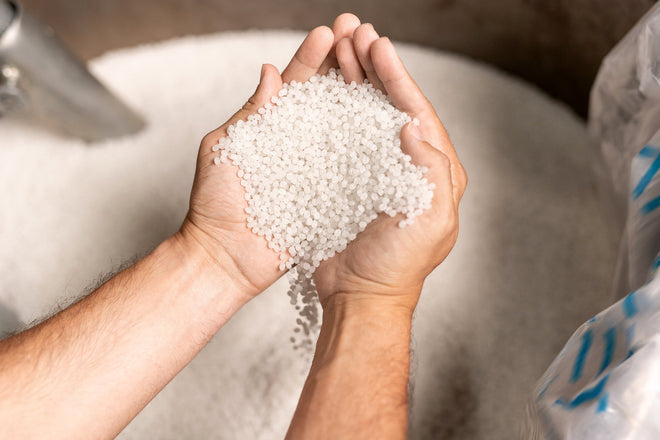When shopping for eyewear, you’ll probably come across the word “acetate” to describe a particular frame. While the word may seem foreign, it’s actually a popular material used to manufacture eyeglass components. The material was first adopted for eyewear production in the 1940s to solve the problems that came with the use of conventional plastic. Acetate is durable, lightweight, and flexible, making it an excellent material for modern glasses.
In this blog, you’ll learn all about acetate - what it is, how it’s made, and the benefits of owning a pair yourself.
What is Acetate?
Acetate is a nylon plant-based polymer (plastic) that is significantly stronger and much more pliable than traditional plastic. It is more impervious to pressure compared to traditional plastic which prevents it from easily breaking.
Acetate is additionally known as cellulose acetate or zylonite. Available in two derivatives, di-acetate and tri-acetate, it’s primarily composed of wood pulp and cotton fibers making it a renewable resource.
Being that it is easy to shape, color, and cut, acetate is used in numerous manufactured products such as packaging, electrical equipment, picture frames, architectural drafting supplies, graphic arts, and even legos.
How Acetate Glasses are Made
Acetate cellulose is made by creating sheets, or film, from raw cellulose. To achieve the rich colors seen in acetate-based eyewear, organic dyes and acetone are added and the layered sheets are then pressed together by large rollers. That said, the process is much more complex than that. The following is the full acetate glasses manufacturing process:
- Cellulose packed cotton and wood is harvested and sent to the factory.
- The cotton and wood are then synthesized to create pure cellulose.
- The pure cellulose is mixed with acetic acid to produce an opaque cellulose acetate compound - a very thick putty-like substance.
- If dying is required, its mixed into the compound by rolling it through large rollers.
- The raw acetate compound is then cast into large blocks via a hydraulic press and then cured.
- Next, the cured blocks of acetate compound are sliced into thin sheets or chipped into small colored pellets. Pellets can be combined to create hybrid sheets for unique tones such as tortoise shell.
- Once the sheets have been produced, they are hung in a heat-stabilizer for several days.
- After the sheets have been heat-stabilized, a CNC milling machine cuts the rough shape of the frame and its components.
- Lastly, the frame and its components are sent to a master craftsman to be finished by hand.
As you can see, manufacturing and producing an acetate frame is quite an effort. The entire process is viewed as a “fine-art” by the optical industry and is what makes acetate such an interesting topic. The entire production process is just one of the many reasons to appreciate acetate glasses.
Advantages of Acetate Frames
There are several advantages to choosing eyewear crafted from acetate. Some of those are:
- Lightweight & Comfortable: Frames made from acetate are lightweight, making them easier to wear for long periods without becoming uncomfortable.
- Durable: Since multiple sheets of acetate are used to craft frames, the result yields a much stronger product than conventional plastic.
- Flexible: Acetate frames can withstand higher levels of stress compared to traditional plastic ones.
- Fashionable: The ability to effortlessly add rich colors to create eye-catching textures makes acetate the go-to material for designing fashionable specs.
- Long-Lasting: Unlike most plastic frames, acetate glasses stand the test of time.
- Affordable: At the end of the day, acetate cellulose isn’t expensive to produce resulting in a low-cost consumer good that is functional, yet fashionable.
- Sustainable: The use of renewable materials to produce acetate rather than petroleum-based ones reduces our carbon footprint.
- Hypoallergenic: Acerate is natural and rarely causes allergic reactions or skin irritation.
- Versatile: Acetate is extremely versatile for eyewear due to its chemical makeup.
The biggest takeaway is that acetate-made eyewear offers durable, long-lasting fashion at an affordable price. When compared to other frames such as metal or traditional plastic, the choice is crystal clear.
Our Acetate Reading Glasses
From Coach to Prada and Persol to Ray-Ban, ReadingGlasses.com offers an enormous selection of both budget and designer reading glasses that are made from all-natural acetate cellulose. Paired with lenses cut and inspected by our in-house lab, each pair of reading glasses comes with a complimentary case to protect your new purchase, along with a free microfiber cloth to help keep them clean and scratch-free.
Looking for acetate reading glasses?





